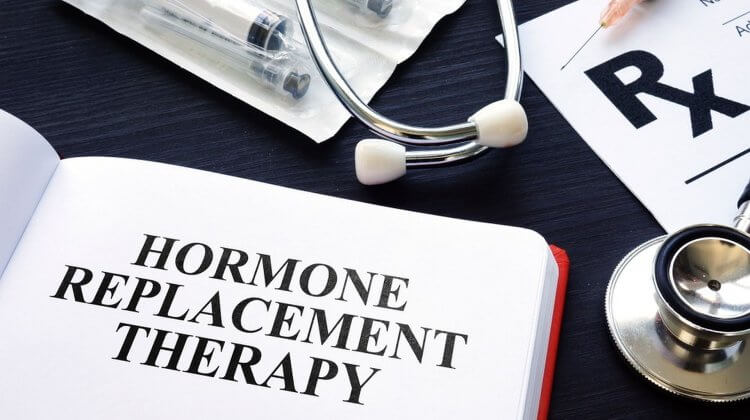
Many post-menopausal women in the United States are on some sort of hormone replacement therapy program. However, I believe that hormone replacement therapy the way it is commonly done may cause more harm than good for many women. I prefer to use a personalized, case-by-case approach for my female patients with the goal to restore a youthful balance of sex hormones similar to what she had when she was in her twenties or thirties.
Testosterone
I get more e-mails about testosterone replacement therapy for women than any other single topic. Many women complain that their own doctor is reluctant to put them on testosterone. Their doctor’s often fear the big “T” and have many misconceptions about it. These women want to know how to find a doctor knowledgeable about testosterone replacement therapy for women. For these women, I have both good news and bad news. The good news is that the pharmaceutical company Unimed will soon be coming out with the first transdermal testosterone gel for women called ReLibra. Unimed will then begin an education campaign to inform doctors around the country about the benefits of testosterone for women. Having FDA approval for a testosterone product for women will undoubtedly make testosterone replacement therapy for women more acceptable among doctors everywhere. The bad news is that ReLibra won’t be getting FDA approval for at least one or two more years.
Believe it or not, there are actually more women who need testosterone replacement therapy than men. This is because even before menopause, many women stop producing testosterone almost completely or have very low levels of free testosterone and precursors such as DHEA and androstenedione. Men, on the other hand, have their total and free testosterone levels slowly go down, as they get older. Since postmenopausal women tend to have miniscule testosterone levels, they are often prime candidates for testosterone replacement therapy. If they have low free testosterone levels and suffer from symptoms such as fatigue, lack of libido, inability to lose weight, and depression, I will consider testosterone as a front line treatment. Testosterone can have pronounced effects on women, as it can radically improve their health and outlook on life. I have seen women make dramatic improvement in their exercise and diet programs. I have seen women overcome fatigue and depression. I have also heard from many satisfied husbands that say I have restored their wive’s sex drives to youthful levels. Even women in their seventies have reported a return of sexual interest and orgasms. Of course, a women wishing to go on testosterone or androgen replacement therapy will have to first undergo a series of hormone tests and screenings for various forms of cancer.
Once I have determined if a women is a candidate for testosterone replacement therapy, I choose one of two treatment options. One option is testosterone prohormones. This allows a, women, to get an occasional boost before sex or before working out. The main testosterone prohormone I use is 4-androstenediol (4-adiol or Androdiol). This is the most potent prohormone for boosting testosterone levels. One female patient measured her testosterone levels, which increased 400% after taking just one quarter of a 12.5 milligram, cyclodiol lozenge. The main problem with prohormones for women is that they generally come only in doses appropriate for a male (100 to 250 milligrams per capsule), and not in doses small enough for a, women (25 milligrams). Some companies sell prohormones in powder or liquid sprays so the doses can be adjusted properly for a, women. Another option is to use a pill cutter to slice up a sublingual Cyclodiol lozenge, and use around 3 or 4 milligrams of 4-adiol sublingually at a time.
The other option I use is a compounded testosterone gel. Even though ReLibra is not yet approved, I can still get a testosterone gel specially formulated for a, women from a number of compounding pharmacies. Transdermal gels are a good delivery system for testosterone as it allows a slow, even release of testosterone into the bloodstream. The testosterone bypasses the liver and testosterone levels are elevated for about six hours. I usually start with a small dose of around .25 milligrams every other morning and increase as needed. It is always best to start low and go slow.
Estrogen
Almost every postmenopausal woman is on some sort of estrogen replacement therapy. I have been fighting a one-man war against the most commonly prescribed drug used for estrogen replacement therapy, Premarin. This is given out almost automatically to women upon menopause. I think this is misguided for two reasons. One reason is that not every women needs to go on estrogen replacement therapy. Estrogen can increase the risk of breast cancer and also lead to unnecessary weight gain. Estrogen is commonly given to livestock to fatten them up, so I find it silly that it is given so frequently to a portion of the population that is most at risk for obesity (yes, middle aged women are at a very high risk of obesity). Natural plant phytoestrogens can give women many of the benefits of estrogen, such as treating hot flash symptoms and lowering the risk of heart disease. Phytoestrogens have the advantage over estrogens in that they may actually lower the risk of breast cancer and do not lead to weight gain. Women in Asia, who generally have a diet richer in plant phytoestrogens and don’t use estrogen replacement therapy as much, are both skinnier and have lower rates of breast cancer.
Another way that I find the common form of estrogen replacement therapy to be misguided is that the estrogen drug Premarin is almost always used rather than natural bio-identical human estrogens. Premarin is an orally administered drug made from the urine of pregnant horses (I kid you not). Some of these horse estrogens are not found in the human body, and likely have different effects than the natural human estrogens estradiol, estrone, and estriol.
If estrogens are necessary then bio-identical estradiol should be used transdermally to avoid weight gain and muscle loss. Oral is not the best delivery system for estrogen and may actually be harmful. One study (1) found that women on Premarin got fatter and lost muscle mass, whereas women on transdermal estradiol had no significant change in body composition. If Premarin is making women fatter while stripping away muscle, it is clearly not a healthy thing for women to be taking. The authors of this study believe that the worsening of body composition in women who took Premarin may be because oral estrogens lower IGF-1 levels. IGF-1 is an anabolic hormone, and the women taking Premarin had a measured drop in IGF-1 levels whereas the women on transdermal estrogen measured no change in IGF-1 levels.
I generally try to get women to eliminate or minimize their estrogen intake as much as possible. If they are successful at treating their hot flashes with plant phytoestrogens alone, I do not encourage them to take estrogen until they are much older and are at greater risk for heart disease, osteoporosis, and mental decline. For those women who find that phytoestrogens are not enough, I prescribe for them natural bio-identical estrogen creams or gels. I favor estradiol over estrone and estriol since these latter two forms of estrogen are possibly transformed into more toxic metabolites (the bad catechol estrogens). And I always encourage my female patients to discontinue taking Premarin.
I have seen many women see great improvements in their weight loss programs when they eliminate or minimize the use of estrogen. If you have been working out and dieting properly for a long time, and just can’t seem to make any progress, it may be due to the excess estrogen you have been putting into your bodies.
Progesterone
Another issue I feel strongly about is the prevalence of synthetic progestins that are given to women instead of natural progesterone. The most commonly prescribed progestin is Provera, which is the brand name for the synthetic drug medroxyprogesterone acetate. Provera is somewhat androgenic like nandrolones, and women can become irritable and agitated from using it. They can also experience other side effects such as acne. On the contrary, natural progesterone can have a calming, relaxing effect on woman.
The combination of estrogens and progestins can often cause tremendous weight gain in women. Estrogen leads to fat storage, whereas progestins can stimulate appetite. Also, progesterone can increase cortisol levels, which will also cause fat gain and muscle loss. Even worse, Provera may actually negate some of the positive effects of estrogen in terms of preventing heart disease (2, 3), and can increase the risk of heart disease and breast cancer in some populations of women. Natural progesterone, on the other hand, may actually increase the effectiveness of estrogen on preventing heart disease (2) or have a neutral effect.
For women wishing to lose weight, I encourage them not to use any progesterone at all and definitely not to use Provera. For women wishing to reduce her risk of endometrial cancer, I may recommend small doses of a natural transdermal progesterone gel. And I always discourage the use of combined Premarin and Provera, which I believe is a travesty against women and may be one of the major factors behind the obesity epidemic in America.
Human Growth Hormone
Many female patients come to me wishing to go on human growth hormone. The media has painted a very glamorous and unrealistic image of growth hormone, often with imagery of a magical “fountain of youth” inducing instant fat loss and youthful looking skin over night. The truth, of course, is not so simple. Growth hormone, especially when combined with testosterone, can in fact help lower body fat levels and increase muscle mass. Some people due see their skin thicken and also feel more energized. However, growth hormone is highly expensive and not everyone notices a large effect from it.
Women in particular are more likely to want to go on growth hormone than testosterone. Growth hormone is widely believed to be safer than testosterone, although I don’t believe this is true (they are both safe if used appropriately, dangerous if abused). The interesting thing is that growth hormone is actually less effective in women than in men, whereas the opposite is true with testosterone. Women need about double the male dose of human growth hormone and do not have the robust result seen in men regarding fat loss. Estrogen may block some of the beneficial effects of growth hormone, and thus women often require a much larger dose of growth hormone than men. Growth hormone is extremely expensive already, so the larger doses often required for women can be astronomically expensive for results that are often transient in many cases.
I usually reserve growth hormone for women with genuine deficiencies in growth hormone production as demonstrated by 24-hour growth hormone level collections, growth hormone stimulation tests, or pituitary disease. For some women who have had great results with their weight loss programs but have reached a plateau, I might put them on a temporary program of growth hormone replacement therapy to help them burn off those last few pounds of fat. But I do warn women that this therapy is highly expensive, and that they might find that they get less than they expected for their money.
Conclusion
If you are a postmenopausal women, I encourage you to talk to your doctor about natural, bio-identical hormone replacement therapy rather than the standard Premarin/Provera combination. If your doctor is not knowledgeable about natural hormones and testosterone for women, feel free to show him or her this article or some of the references below. If your doctor is still skeptical or unwilling to consider natural alternatives to Premarin and Provera, you may want to consider switching doctors. Some good physician referral listings are kept by, both the Cognitive Enhancement Research Institute and the American Academy of Anti-Aging Medicine. While I obviously can’t vouch for every doctor on their lists, these doctors are far more likely to be sympathetic to the kinds of treatments I have outlined in this article than your average doctor.
Regardless of what choice of hormone replacement therapy you choose, become informed. Don’t believe everything your doctor tells you or all the promotional materials produced by the pharmaceutical companies. Successful hormone replacement therapy must be personalized to meet your goals and to match your individual health history. I also strongly believe that your body will react best to natural, human hormones that were present in your body before menopause rather than the synthetic and often toxic hormones that are normally prescribed for women.
References:
1. O’Sullivan AJ, et al.,The route of estrogen replacement therapy confers divergent effects on substrate oxidation and body composition in postmenopausal women. , J Clin Invest. 1998 Sep 1;102(5):1035-40.
2. Rosano GM, et al, Natural progesterone, but not medroxyprogesterone acetate, enhances the beneficial effect of estrogen on exercise-induced myocardial ischemia in postmenopausal women. J Am Coll Cardiol. 2000 Dec;36(7):2154-9.
3. Lindoff C, et al, Transdermal estrogen replacement therapy: beneficial effects on hemostatic risk factors for cardiovascular disease. Maturitas. 1996 May;24(1-2):43-50.
About the author
Warning: Undefined array key "display_name" in /home/thinksteroids/public_html/wp-content/plugins/molongui-authorship-pro/includes/hooks/author/box/data.php on line 11
Warning: Undefined array key "display_name" in /home/thinksteroids/public_html/wp-content/plugins/molongui-authorship-pro/includes/hooks/author/box/data.php on line 11
Warning: Undefined variable $show_related in /home/thinksteroids/public_html/wp-content/plugins/molongui-authorship/views/author-box/parts/html-tabs.php on line 30


Leave a Reply
You must be logged in to post a comment.